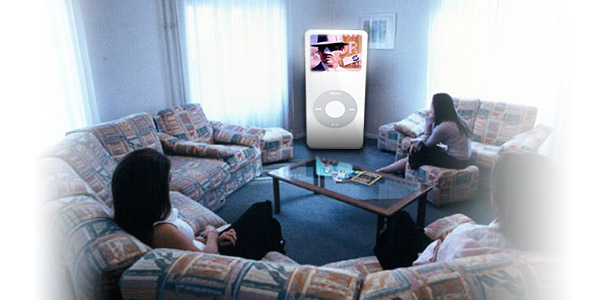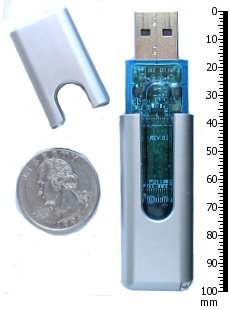2006-09-12
No one wants full length portable movies, I bet!~~

Apple is set to start offering full-length movies for download through iTunes for viewing on iPods and Sprint is "renting" movies for people to watch on their cell phones. With these developments, one might think that there's a small-screen revolution going on and that consumers are clamoring for ways to watch movies on the go. But are they? Do people really want to watch a two-hour movie on a 1.5-inch screen? I really doubt it. Gadget makers and content distributors need to reexamine how people watch videos on the go and cater more towards the realities of the market rather than wishing for a world in which people will be excited to drop $10 on a low-quality version of a movie they can watch only on a tiny screen.
People like watching movies in traditional places: namely, the theater or the living room. Pay-to-download sites such as Vongo haven't really caught on, and for good reason. While watching a movie on your laptop once in a while is fine, it really doesn't compete to sitting on the couch and watching it on TV. If people don't want to pay to watch a movie on their laptops, why would they pay to watch them on their iPods? First of all, the quality is just not up to snuff. Those tiny screens are okay for watching music videos, but to stare at one for 2 hours is far from a comfortable viewing experience. Secondly, you need to think about what situations people will be in when they're going to watch a movie on their phone. It seems like the most logical place to watch a movie on the go would be while traveling, as there really aren't too many other times that you'll be stationary for a couple of hours and want to be distracted. However, laptops are a much better way to watch movies on the go, and if you are going to pay for your movies wouldn't you rather have a DVD you can use on a laptop or at home than a digital copy that's trapped on your phone or iPod?
If you look at what videos are popular on the Internet, you'll see that shorter is better. Sites like YouTube are totally full of videos that clock in well under the 5-minute mark, and these are the types of videos that people would be more interested in watching on portable devices. After all, if you're in a waiting room or on the subway and want to watch something, you don't want to get sucked into Rumor Has It, you want something that will fit into the time you have. There are already applications out there to put YouTube videos on your iPod, and no rental or purchase fee is required. iTube for Windows and PodTube for OS X both do the work of converting and transferring YouTube videos to your iPod, and this is the perfect solution to people who want to have free, short video content for their portables.
Downloading movies is something that will catch on eventually, but it has to be done in the right way. The rumored Netflix set-top box is exactly the type of thing that consumers will embrace. It gives them the luxury of downloading something without leaving their house and lets them watch movies where they want to ? the living room. Companies such as Apple and Sprint want to get in on movie downloading, but portables are just not the venue that will make it catch on. Watching videos on your phone or music player is a novelty, one that demands content that's somewhat disposable as well. Until that happens, don't expect to see legions of people watching Little Man on their phones anytime soon. ? A.F.
Mobile phones could become portable TV recorders
Texas Instruments is set to introduce a mobile phone that can record TV programmes using the DVB-H handheld digital video broadcast standard to record short extracts of TV for later viewing. It will also have picture-in-picture (PIP) technology (hope it has a big screen) to allow two programmes to be watched at once.
TI have done research that suggests mobile users would watch up to 3 hours of TV per day on their phones, but in snippets of 2-10 minutes at a time and particularly during a commute and at meal times.
Whether it will catch oon will depend upon broadcasters providing content in this format, operators streaming in, and consumers actually wanting it. The actual technology is expected to be available en masse during 2007.
It could be something that increases in popularity though. ITV recently started streaming ITV1 and ITV Play to the 3 Network.
Are you interested in mobile TV, and what sort of devices would you want to be able to watch it on?
TI have done research that suggests mobile users would watch up to 3 hours of TV per day on their phones, but in snippets of 2-10 minutes at a time and particularly during a commute and at meal times.
Whether it will catch oon will depend upon broadcasters providing content in this format, operators streaming in, and consumers actually wanting it. The actual technology is expected to be available en masse during 2007.
It could be something that increases in popularity though. ITV recently started streaming ITV1 and ITV Play to the 3 Network.
Are you interested in mobile TV, and what sort of devices would you want to be able to watch it on?
Fun with Portable Software

The latest trend in the computer industry is making a big splash despite its small frame.
Small, portable, USB compatible devices, capable of holding several gigabytes of data, are a viable alternative to compact disk media for file transfers and data storage. The two mediums have combined to crush the archaic floppy disk under the weight of its own 1.44 megabytes.
These thumb-sized vaults of information have found a new and immediately popular niche in their ability, thanks to faster USB technology, to run full program applications at speeds comparable to native hard disk access. This realization has led to an entire industry filled with "portable applications" ? software programs that run completely on removable USB memory drives and make no changes to system settings or files. This development adds new meaning to the words plug and play. When the user is finished, the drive can be unplugged and used in the exact same way on a different computer.
Most of the currently available portable applications are freeware, meaning they can be used free of charge without limitation, and many of them, including portable versions of Mozilla Firefox and Thunderbird, are part of the open source software revolution.
One of the more popular sources of self-named portable software is PortableApps.com. The consistently updates site has the latest portable/standalone versions of Firefox, Thunderbird and a variety of other useful applications including the popular Microsoft Office replacement, Open Office and a fully functional visual FTP client.
A second site that makes the rag cut is The Portable Freeware Collection. This site gets the PRrag seal of approval because its owner not only makes constant updates, but consistently removes software from the database if it contains any form of adware or spyware or makes any changes to your system settings or hard disk.
This is why open source, non commercial, software is working so well and becoming so popular. Before the open source boom, you couldn't download a simple program without facing the consequences of unwanted advertisement software and other computer-slowing, security-compromising junk. In those days, between 2001 and early 2004, unwanted programs ruled the land and were a far greater security risk than any virus or worm at the time.
That was the age of the spyware. The age after the basic death of Netscape and prior to the stable release of Firefox, which was released in September, 2002 under the name "Phoenix."
The PR guy wanted to give portability a try, so I purchased an RiData 2GB USB 2.0 compatable drive. It is a little wider than I was expecting but lightweight and inexpensive.
Using Firefox and Thunderbird along with the rest of the PortableApps Suite, I also gave myself Gimp Portable, a lightweight open source graphic and photo editing solution.
I like it. The only thing I'd worry about is that if this takes off and people start to rely on the portable applications and their password saving features, USB drives will become more valuable than wallets. The lesson here is that you should always protect your data. If you're prone to losing things, do not save your passwords on your portable apps.
Another feature is the convenience of Open Office. This is a full feature productivity suite with most of the bells and whistles you'd see in comparable commercial products, and it's free and open source means anyone with the ability can take its code and turn it into whatever their heart desired.
Thus, the age of spyware closed and the age of open source, transparent, software has emerged. The only question that remains is, what comes next?

